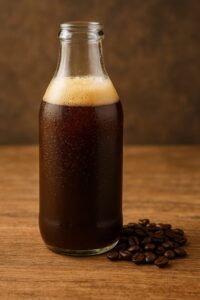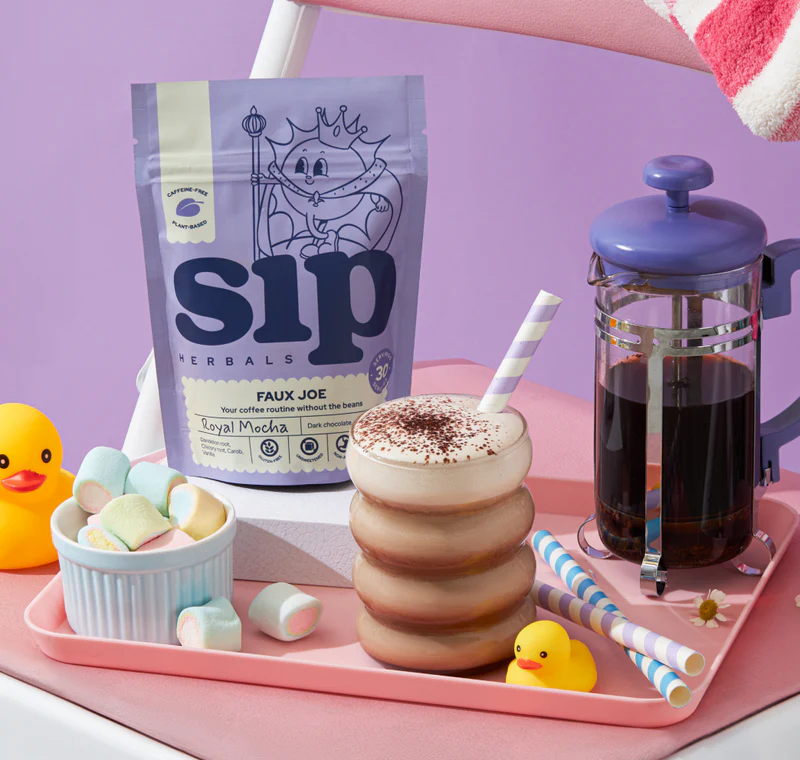Brew Bold. Sip Better.
Coffee Meets Kombucha
Discover the fusion of ancient wellness and modern flavor in every glass, from the refreshing tang of Kombucha to the rich depth of Coffee, enhanced with nature’s best.
Kombucha’s bold tang and coffee’s robust complexity are a surprisingly perfect match. We’re developing a set of recipes that combine these two powerhouses, energizing, gut-friendly, and uniquely flavorful.

Kombuffee: The Master Recipe 🗝️
How to make coffee kombucha
Ingredients:
4 quarts water
⅓ cup ground coffee
1 cup sugar
1 SCOBY
1 cup starter liquid

Quick Directions: Brew ⅓ cup ground coffee in 1 quart of hot water for 5–7 minutes, strain, then stir in 1 cup sugar until dissolved. Pour into 3 quarts of cool water in your brewing vessel, add 1 SCOBY and 1 cup starter liquid, cover, and ferment 5+ days until it tastes good, then bottle to carbonate for 1–4 days if desired.
Our coffee recommendations for brewing the best kombuffee ☕
Happy Gut Coffee is a low-acid, mold-free coffee crafted to support gut health while delivering a smooth, rich taste. Made from organic, sustainably sourced beans, it’s tested for mycotoxins and roasted to reduce acidity, making it gentle on digestion without sacrificing the coffee ritual you love. Perfect for those seeking to enjoy coffee without bloating or discomfort, Happy Gut Coffee helps you start your day energized while prioritizing your microbiome and overall wellness.


Sip Herbals offers delicious, caffeine-free herbal coffee substitutes crafted from roasted chicory, carob, dandelion, and other nourishing herbs, delivering the rich, roasty flavor of coffee without the jitters or acidity. Perfect for those reducing caffeine or seeking a gentle morning ritual, Sip Herbals blends are gut-friendly, easy to brew, and versatile for lattes, iced coffee, or baking. With zero added sugar and a focus on real ingredients, Sip Herbals helps you savor the coffee experience while supporting your wellness goals naturally.
Turn your kitchen into a kombuffee cafe
Below are four of our very favorite Kombuffee/Koffucha recipes that we would recommend for dipping your feet into the wonderful, complex world of more distinctly-flavored Kombuchas. Each of the following recipes will make one 16oz bottle – Recipes for Full Gallons (with exact measurements) can be found in The Big Book of Kombucha.
Turkish Coffee
DATES, CHOPPED
– 1 tablespoon
BREWED COFFEE
– 1 tablespoon
CARDAMOM, GROUND
– ⅛ teaspoon
CLOVES, GROUND
– ⅛ teaspoon
Moroccan Coffee
CHAI SPICE BLEND, HAND-GROUND
– ½ teaspoon
GROUND COFFEE
– 1 teaspoon
Starbucha
WHOLE VANILLA BEAN, SLICED
– ¼ bean
BREWED COFFEE
– ⅛ cup
Sassachino
BREWED COFFEE
– 2 tablespoons
SASSAFRAS POWDER
– 1 teaspoon

Coffee Kombucha FAQ
1. What is coffee Kombucha and how is it made?
Coffee Kombucha is a fermented beverage made by brewing coffee and fermenting it with a SCOBY (Symbiotic Culture of Bacteria and Yeast), similar to traditional tea-based Kombucha. It undergoes the same fermentation process, creating a tangy, lightly effervescent drink with natural probiotics.
2. Does coffee Kombucha have caffeine?
Yes, coffee Kombucha contains caffeine. The amount depends on the coffee used and the length of fermentation, but it generally contains less caffeine than regular brewed coffee.
3. Is coffee Kombucha good for you?
Coffee Kombucha may offer gut health benefits from probiotics, along with natural antioxidants from coffee. It can support digestion and provide a gentler caffeine boost, though individual results may vary.
4. What does coffee Kombucha taste like?
Coffee Kombucha has a complex flavor that combines the deep, rich notes of coffee with the tart, slightly sweet profile of Kombucha. It can be nutty, chocolaty, or fruity depending on the beans and fermentation.
5. Can you brew Kombucha with coffee instead of tea?
Yes, you can brew Kombucha with coffee instead of tea. However, because coffee is more acidic and contains different oils, the SCOBY may degrade over time. Many brewers recommend using a backup SCOBY or alternating with tea-based batches.
6. Does coffee Kombucha still have probiotics?
Yes, if properly fermented, coffee Kombucha still contains live probiotics and beneficial acids. The fermentation process creates a living beverage with gut-supportive microbes, though strain variety may differ from tea Kombucha.
7. How much caffeine is in coffee Kombucha compared to regular coffee or tea?
Coffee Kombucha typically contains less caffeine than regular brewed coffee, but more than tea-based Kombucha. A serving may contain anywhere from 30–80 mg of caffeine, depending on brew strength and fermentation time.
8. Will coffee Kombucha keep me awake like regular coffee?
It can provide a milder energy boost due to its caffeine content. However, the fermentation process may reduce caffeine slightly, and the presence of L-theanine-like compounds in fermented beverages can offer smoother energy without jitters.
9. Can I make coffee Kombucha at home? What do I need?
Yes! To make coffee Kombucha at home, you’ll need brewed coffee (cooled), sugar, a healthy SCOBY (get yours here), and a glass fermenting jar. Use filtered water (we LOVE the AquaTru system) and avoid flavored or oily coffees for best results. Monitor the SCOBY for signs of stress.
10. Is coffee Kombucha safe for people sensitive to caffeine or acidity?
People sensitive to caffeine or acidic drinks should approach coffee Kombucha with caution. It may still trigger sensitivity due to residual caffeine and acidity. Start with small servings and consult a healthcare provider if unsure.
